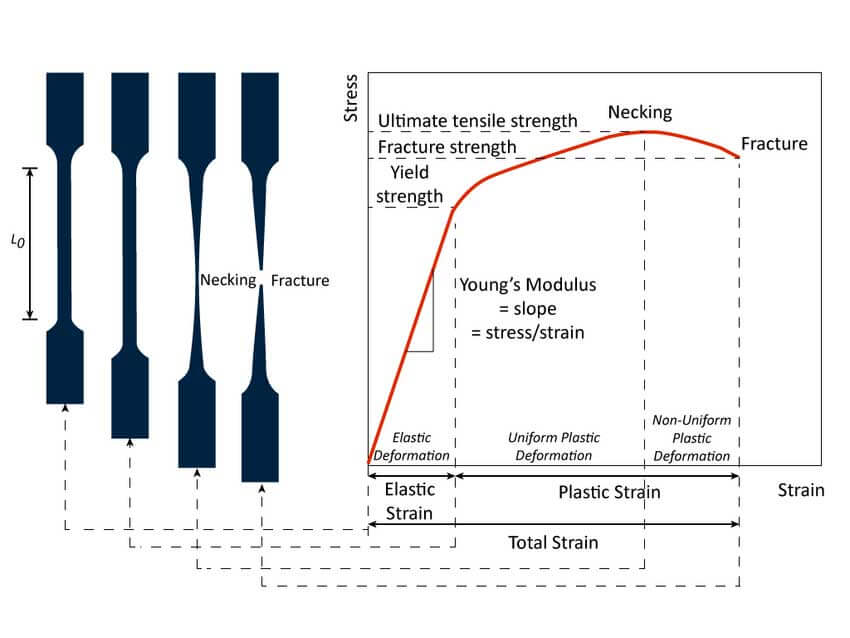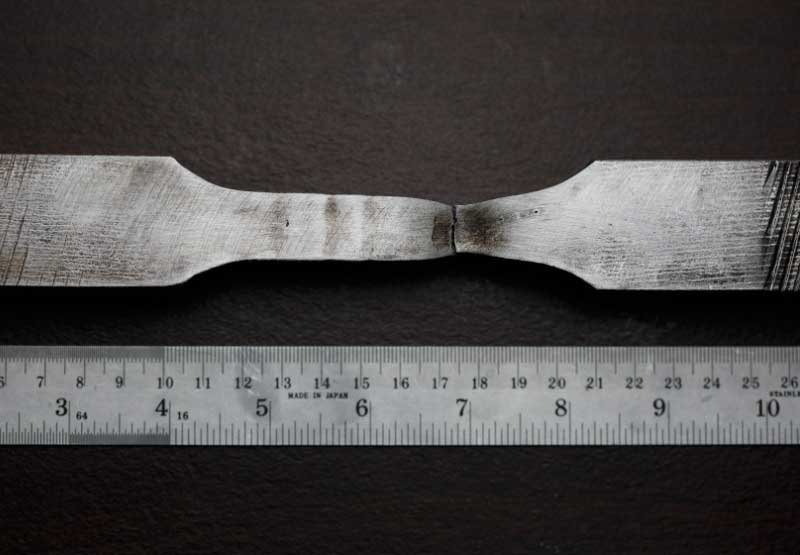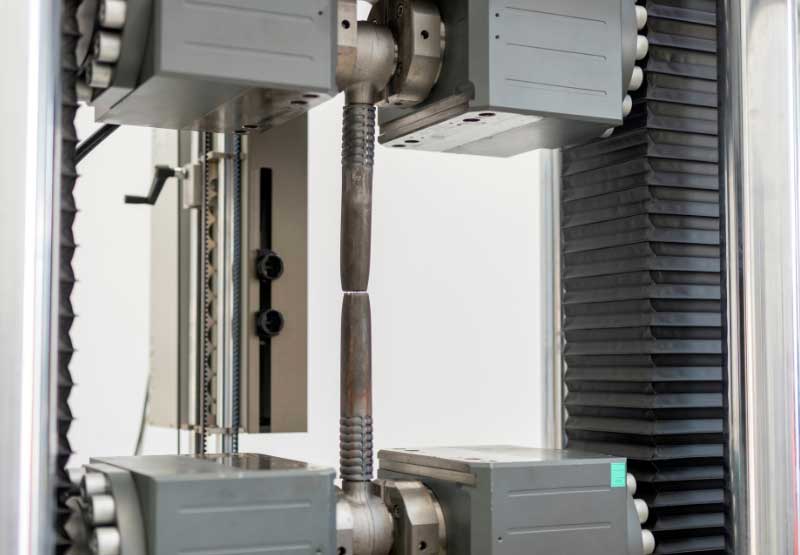Do you need to know more about tensile testing? If so, this guide is for you. Tensile testing is an integral part of quality control and materials analysis, essential for ensuring the performance and safety of a wide range of products.
We will discuss the different methods employed in this process, their applications, and their techniques. So, read on if you are ready to become an expert in material tensile testing, from preparing the test specimen procedure to correctly interpreting results!
What Is Tensile Testing and How Does It Work
Tensile testing is a required method of testing the mechanical properties of materials. Engineers use it to determine how a material will behave under tensile stress and strain, the amount of force pulling it apart.
During tensile testing, a material sample is subjected to a controlled stretching force and monitored for length and deformation changes. This information calculates the material’s tensile strength, elasticity, ductility, and other characteristics.
Stress-strain curve
The stress-strain curve is the output of the material tensile testing. It provides a graphical representation of the relationship between stress and strain in a material subjected to a mechanical load.
By analyzing the curve, we can determine the mechanical properties of a material, such as its elastic modulus, yield strength, ultimate strength, and ductility.
A stress-strain curve is essential in materials testing, allowing engineers to design and optimize structures for specific applications.

Yield Strength
Yield strength is a mechanical property that determines the stress level at which materials begin to deform plastically. It is a crucial parameter when designing structures or materials that will be subjected to loads, as understanding the point at which a material will start to deform in a plastic manner is essential in preventing failures.
To accurately determine yield strength, researchers and engineers often use extensometers, instruments that can measure the elongation of a material under load. With extensometers, researchers can accurately calculate the upper yield strength, which occurs when the material begins to deform in a plastic manner, and the lower yield strength, which is the point at which the material starts to deform unevenly.
Ultimate Tensile Strength (UTS)
Ultimate Tensile Strength (UTS) is the maximum stress a material can withstand before it fails in a tensile testing environment. This measurement is critical because it represents the upper limit of a material’s ability to withstand high stresses without breaking. It is an essential mechanical property that helps determine the suitability of a material for various applications.
In tensile testing, UTS is calculated by dividing the maximum load applied to the specimen by its cross-sectional area. The result is the maximum stress that the material can withstand before a fracture occurs.
This information and other mechanical properties, such as elongation and yield strength, can help engineers understand how a material will behave under different conditions.
Ductility
Ductility refers to the ability of a material to undergo plastic deformation without fracturing. It is an essential mechanical property that is evaluated in tensile testing. The percentage of elongation is a measure of ductility that is commonly used by engineers and materials scientists.
It is calculated by dividing the increase in length of a specimen after it has been stretched to its maximum by its original length and then multiplying the result by 100. In addition to the percentage of elongation, the fracture surface of a specimen after a tensile test can also provide insights into its ductility.
Brittle materials exhibit a smooth, crystalline fracture surface, while ductile materials have a more rough and textured surface.
Ductility is crucial for metals used in various applications, such as construction, transportation, and manufacturing.
Modulus of Elasticity
The Modulus of Elasticity, or Young’s Modulus, is a crucial mechanical property of materials that measures their stiffness. It represents the ratio of stress to strain within the elastic deformation limit of a material. The Modulus of Elasticity determines how much a material can be stretched or compressed within its elastic limit without undergoing permanent deformation.
The significance of the Modulus of Elasticity lies in its ability to provide information about the stiffness and strength of a material. The higher the Modulus of Elasticity, the stiffer the material is, and the less it will deform under a given load. Conversely, materials with a lower Modulus of Elasticity are more flexible and prone to deformation under stress.
Why Use Tensile Testing?
Tensile testing is an essential type of materials testing that helps determine the mechanical properties of a material. It measures tensile strength, the maximum stress a material can withstand without breaking when subjected to a stretching force.
Tensile testing can measure several mechanical properties like the elastic modulus of a material, the yield strength, ultimate tensile strength, and elongation at break. These properties can provide valuable information about the material’s quality and performance in various applications.
Performing tensile tests has many benefits. Firstly, it can provide manufacturers and engineers with a detailed understanding of the structure and behavior of a material under tensile stress. This information can then be used to ensure that the material meets the requirements for the intended application.
It is also essential to ensure that the tensile test is performed according to internationally recognized testing standards to ensure consistency in test results. Industry standards like ASTM E8 and ASTM D3039 specify the methods for conducting tensile tests, including the testing equipment and data analysis techniques.
Types of Tensile Tests
Various types of tensile tests are conducted depending on the type of material, the purpose of the test, and the required results.
The most widely used types of tensile tests include:
- The standard tensile test.
- The uniaxial tensile test.
- The transverse tensile test.
- The biaxial tensile test.
Each test measures the tensile strength, toughness, and ductility of different materials such as metals, plastics, and composites.
Tests of uniaxial tensile strength are generally considered the technique of choice when analyzing the mechanical properties of isotropic materials. Testing for biaxial tensile strength is performed on a wide range of materials.
Tensile Specimen Preparation
To perform a successful tensile test, it is crucial to prepare the specimens properly. Firstly, the material to be tested must be selected and ordered with the correct dimensions and specifications. The next step is to prepare the material for tensile testing by reducing its cross-sectional dimensions.
Reducing cross-sectional dimensions is necessary because the force (load) the machine applies to the specimen during the test must be distributed uniformly across its entire surface.
After reducing the cross-sectional dimensions, it is time to shape the material into the appropriate geometry. Generally, dumbbell or dog bone shapes are used for the grips of the tensile testing machine to pull apart.
These shapes provide greater surface area for the grips to hold onto during testing. A dumbbell shape is where the center of the specimen is narrower than the ends. A dog bone shape is where the center of the sample is wider than the ends.
Once the material has been shaped, the specimen’s gauge length and shoulders must be defined. The gauge length is the section of the model that the machine will stretch to measure its deformation. The shoulders are the sections of the specimen that are attached to the testing apparatus. Defining these dimensions accurately is essential as they impact the test results.

Finally, the specimens are checked for any surface defects before placing them onto the grips of the testing machine. The grips are carefully aligned with the specimen’s shoulders, ensuring the gauge length is accurately measured.
Techniques Used in Tensile Testing
The tensile test involves pulling a specimen apart along its longitudinal axis until it breaks. However, tensile testing is not limited to just pulling. Different techniques are used in tensile testing, such as pulling, stretching, and compression.
Pulling is the most commonly used technique in tensile testing, also known as tension testing. It involves applying a uniaxial force that pulls the material apart. The specimen is placed by grips, and the testing machine uses an increasing load until the specimen fractures. The goal is to measure the material’s tensile strength, which measures how much stress the material can handle before breaking.
Stretching is another technique used in tensile testing but requires a more complex testing setup. Rather than pulling the specimen apart, stretching involves elongating the material along a chosen axis while compressing it along the opposite axis. This technique helps measure the material’s anisotropy or how its properties change based on the direction of application.
Compression is a technique used in tensile testing but is fundamentally different from pulling and stretching. It involves applying a compressive force instead of a tensile force on the material. Compression testing measures the material’s compressive strength, which is the maximum stress the material can withstand before breaking under compression.
Applications of Tensile Testing
Tensile testing is an essential aspect of materials engineering with various industrial applications. Its primary use is determining materials’ mechanical properties and their stress response. The results of tensile testing are used to evaluate the manufacture and quality control of materials used in different applications.
Manufacturing is one of the most common areas where tensile testing is used. Materials such as metals, plastics, and composites undergo tensile testing to determine their strength, elasticity, and ductility. The results of these tests help identify any defects in the materials that could affect their quality and suitability for the intended application.
In the construction industry, tensile testing is often used to evaluate the durability and resistance of construction materials to stress and environmental conditions. In this field, testing is crucial in determining the material’s ability to withstand the weight, load, and strain during construction and its lifespan.
Aerospace is another industry where tensile testing is frequently used. Materials used in the aerospace industry need to meet strict safety and quality standards. Tensile testing ensures that the materials used in constructing airplanes, spaceships, and satellites are strong enough to withstand the stresses of flight and exposure to extreme temperatures and conditions.
Tensile testing is also vital in materials research. Scientists and researchers use tensile testing to study the properties of various materials and understand their behavior under different conditions. This information is instrumental in developing new materials that can withstand extreme temperatures and environmental conditions.
Tensile test can be performed at elevated temperatures to simulate conditions the material may experience during its lifetime. This testing helps determine the strength and performance of materials in high-temperature applications such as exhaust systems and turbines.
Different Machines Used for Testing
Tensile testing machines come in various types and designs, and the choice of machine depends on the type of material and product being tested and the specific testing requirements. The two main types of tensile testing machines are hydraulic and electromechanical machines.
Hydraulic machines use hydraulic fluid to generate force, making them suitable for testing high-force materials. These machines can handle force capacities of up to several million pounds, making them ideal for testing materials with high tensile strengths, such as metals, alloys, and composites. Hydraulic machines can operate relatively slower but offer high accuracy and resolution.
On the other hand, electromechanical machines use an electric motor to generate force and handle lower force capacities than hydraulic machines. Electromechanical machines are more versatile than hydraulic machines and can test various materials, including plastics, rubbers, and textiles. They offer high speeds and excellent accuracy and resolution.
Tensile Testing Standards
Tensile testing standards are essential in ensuring that the quality of materials used in various industries meets the requirements. The standards of tensile tests dictate the procedures and parameters that must be followed for accurate and repeatable results.
These standards are set by various organizations, such as ASTM International and ISO, and are designed to ensure product quality and improve workplace safety. Among the many standards, the following are commonly used:
- Tensile Properties of Vulcanized Rubber and Thermoplastic Elastomers according to ASTM D412.
- Plastics Tensile Properties according to ASTM D638.
- Thin plastic sheeting’s tensile properties according to ASTM D882.
- Tension Tests for Metals under ASTM E8.
- Tensile Properties of Polymer Matrix Composite Materials according to ASTM D3039.
Understanding and adhering to these standards is crucial in achieving reliable and consistent results in tensile testing and ensuring the manufacturing process’s overall success.
Conclusion
Professional engineers understand that the tensile properties of materials are critical to the design of many structures. Engineers can predict their performance under different loads by analyzing the stress-strain relationship of various metallic materials.
Today, many different tensile testing systems are available, allowing for design enhancements, consistent manufacturing, and increased productivity. A quick product launch can maximize revenue and profit while reducing material costs and helping achieve lean manufacturing goals. As a result, choosing the right tensile testing system can be crucial to the success of any engineering project.
References:









